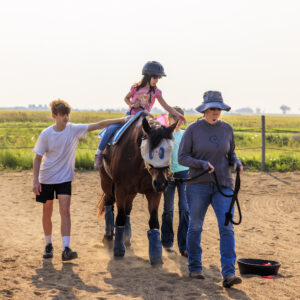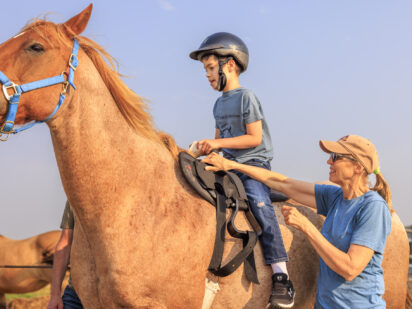In 1993, Nancy Gasmann, Physical Therapy Manager with Trinity Health who recently celebrated 40 years with the organization, helped initiate the hippotherapy program at the Dakota Boys and Girls Ranch. That would not be the last time Gasmann was involved with a hippotherapy program and the many benefits that it brings to children of the Minot community.
In 2018, Gasmann and Trinity Health were able to team up with Kristi Schaefer, the Executive Director of Serenity Therapeutic Equine Program (STEP), in an effort to expand the pediatric therapy options offered by Trinity Health.
The pair has a history of working together, as Schaefer started volunteering at the Dakota Boys and Girls Ranch to help with the hippotherapy program in 1995. Schaefer then ran the program at the Dakota Boys and Girls Ranch from 2005-2010 before starting STEP in the fall of 2010 with the first riders participating in 2011.
According to the American Hippotherapy Association, hippotherapy refers to the use of the movement of a horse as a treatment strategy to address impairments, functional limitations and disabilities in patients with neuromusculoskeletal dysfunctions. But why the horse? It starts with the similarities between the way humans and horses walk.
“A horse’s walk is very similar to our walk regarding the movements. A person may be struggling with their balance or coordination when they’re riding the horse, but they are getting that same input that we would want them to have while walking, so we use the horse for therapy that way,” said Schaefer.
Riding a horse, however, isn’t the only activity the children do during their appointments with STEP. Gasmann and Schaefer make sure they focus on keeping the children engaged while they build the strength and skills necessary for daily living.
“We play a bunch of games because most of our riders are kids, so we play games to get them engaged in doing their therapy. Otherwise, nobody likes to do therapy. We play basketball which works on their range of motion. They also work on building strength in their core muscles while focusing on stability when they ride the horses,” Schaefer added.
The activities don’t stop there. With the goal of targeting multiple tasks or accomplishments in one activity, playing matching games and balancing an egg on a spoon are just two more of the many things the kids do while riding a horse.

“We do activities where we have the kids match things, which promotes following directions. While we work on matching, the kids also have to reach, so we’re doing both cognitive and physical tasks with them,” Schaefer said.
Not only do these activities help the kids complete cognitive and physical tasks, but they also serve as an opportunity to boost the self-esteem and confidence in themselves by feeling a sense of much-deserved pride after successfully completing the activities.
Confidence doesn’t only build because of their ability to complete the tasks, however. As the kids go through more and more sessions of the program, they begin to feel much more confident about getting on and riding a horse, which is a very intimidating task at first.
“Many of the kids have not been on a horse or been around a horse before, so they may have some fear with getting on them. By the end of the summer, they are usually all up there getting on the horses and I have to hold them back,” Gasmann said.
“The kids usually have gained great confidence by being able to come out here and ride the horses. They also usually see the same people every time, so they love talking to the same volunteers. It really makes a big difference as far as just improving their confidence and self-esteem.”
Volunteers are a big part of the equation as well, as they not only help the program run smoothly every day, but they also get to help the kids work on their social skills as they communicate throughout their time working together.
“We have some wonderful volunteers. Our volunteers that we have are our core volunteers that come out and they work with the same clients every time, so they get to know those kids. They talk to those kids, and we oftentimes do a group of horses at the same time, so then they work with the other partner to do different things with the kids in the arena,” said Gasmann.
The volunteers, along with Gasmann and Schaefer, are the “side walkers” who walk along the side of the horse. They lead the activities in order to keep the environment controlled and to make it safe for everyone involved. Schaefer noted that the kids really look forward to seeing their volunteers each week, and that it is clear they have built a relationship with them.
Sessions of hippotherapy typically run for 10 weeks and only occur during the summer. On an average day, they will see a variety of children from morning until late afternoon. The riders will come at the same time every week and the sessions will go for 30 or 45 minutes depending on the heat that day.
Even though hippotherapy can only take place in the summer due to the frigid climate of North Dakota, it’s something the kids always look forward to. When not in season, they are counting down the days until they can get back on a horse again.
The excitement of riding a horse and the many benefits that develop during the sessions, paired with the uniqueness of the hippotherapy program, truly help the children take a STEP in the right direction.

